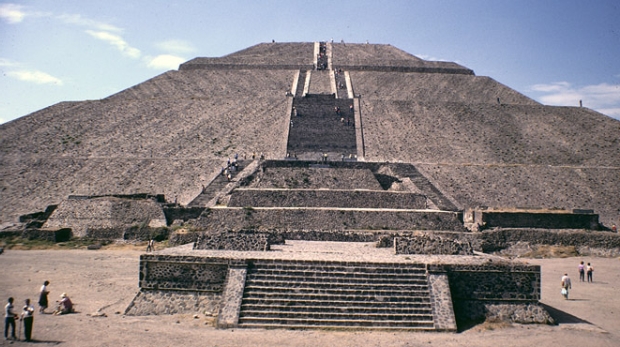An ancient religious capital of Mexico thrived a thousand years before the height of the Aztec Empire. In spite of more than a century of painstaking archaeological research, no one knows who built it, or when, or why – and even its demise is shrouded in mystery. In translation its name means ‘city where men become gods’; Teotihuacan more than lives up to that promise.
{This is a Series of Excerpts from the book Strange Worlds Amazing Places: A Tour of Earths Marvels and Mysteries, Get it Here}
It is the largest and most impressive of Mexico’s pre-Columbian cities, situated some 7500ft (about 2285m) above sea level on the Mexican plateau, almost exactly the same altitude as the other great new World metropolis, Machu Picchu in Peru. There the similarity ends. While the latter is squeezed into precipitous ravines, the spacious plain chosen as the site for Teotihuacan gave its builders free rein. The city covers about 9 sq. miles (23km), and its biggest building, the Pyramid of the Sun, is larger than the Colosseum in Rome which was erected at the same time.

Little is known about Teotihuacan. It was once thought to have been built by the Aztecs, but the city had been abandoned for some 700 years when they discovered and named it in the 15th century. Even the identity of the original builders is unknown, but for convenience they are sometimes referred to as the ‘Teotihuacanos’. Nor are there any historical records: what little is known about this ancient place has come solely from archaeological research.
There is evidence that the area was occupied as early as the fourth century BC, but Teotihuacan’s most magnificent period was from the second to the seventh centuries AD. The present ruins are probably those of a city built around the time of the birth of Christ by a workforce drawn from a population estimated to have totaled 200,000 – making Teotihuacan the sixth largest city in the world at that time.
At its zenith the city of Teotihuacan dominated the whole Central America in cultural terms. Its potters produced vase-shaped and cylindrical vessels with three slab-shaped feet and stuccoed and painted decoration. Its most impressive sculptures are austere stone masks fashioned from greenstone, basalt and jade, and with eyes carved from obsidian or mussel-shell. Obsidian may have been the foundation of the city’s wealth. This dark, glassy mineral, which came from nearby volcanoes, was highly prized, for it could be easily sharpened into blades for tools and weapons.
The people of Teotihuacan traded throughout Mexico’s central highlands, and possibly through the rest of Central America too. Vases from the city have been found in graves all over Mexico. It is uncertain, however, whether the city established a political empire outside its own boundaries. Murals excavated from the site depict few military scenes, which suggest that the Teotihuacanos were not aggressive.
The skill of Teotihuacan’s craftsmen was exceeded only by the unparalleled architectural genius of its planners. The city is organized on a giant grid whose baseline is the 2 mile (3.2km) long principal thoroughfare, the Avenue of the Dead (named by the Aztecs, who mistook the platforms that lie the route for tombs). At its northern extremity is Ciudadela, the ‘citadel’, an enormous enclosure which houses the Temple of Quetzalcoatl, the serpent god.

The Pyramid of the Sun, which dominates the site, was built on the ruins of an earlier structure. Some 20ft (6m) below its base, and extending for about 330ft (100m), is a natural cavern that was a sacred place both before and after the 2.5 million tons of dried mud bricks were hoisted into the 2.5 million tons of dried mud bricks were hoisted into place. Built of sun-dried bricks called adobe, and estimated to have taken 3000 men, without the aid of pack animals, metal tools or the wheel 30 years to construct the Pyramid of the Sun.

The Pyramid of the Moon is architecturally more complex with the lower tier of its main face consisting of several interlocking sloping stages rather than a single continuous incline. And unlike the pyramids of Egypt, those at Teotihuacan were not used as tombs, but were temple platforms. No one can be sure of the true significance of the Pyramid of the Sun, but since it is aligned on an east-west axis to follow the path of the sun across the sky it has been seen as representing the centre of the universe: its four corners are the four principal points of the compass, and its apex Is the heart of life.

The religious buildings were not the only architectural wonders of Teotihuacan. Modern excavations of some of its palaces have revealed that each was constructed on the same geometric principles, with their many rooms arranged around a central courtyard. Although the roofs are missing, the walls are decorated with carvings and boldly designed frescoes whose reds, browns, blues and yellows are still vibrant.
No one knows what brought about the downfall of this great city and civilization. The remains of charred roof beams support the theory that the city was sacked around AD 740, possibly by the Toltecs, who ruled the region from the 10th to the 12th centuries. A few survivors lived in Teotihuacan after the devastation, but its days as a thriving metropolis ere over. Today, a visitor who stands in the ruins with nothing on the horizon but mountains and sky, might find it difficult to believe that Mexico City lies just 30 miles (488 km) to the south-west.



































